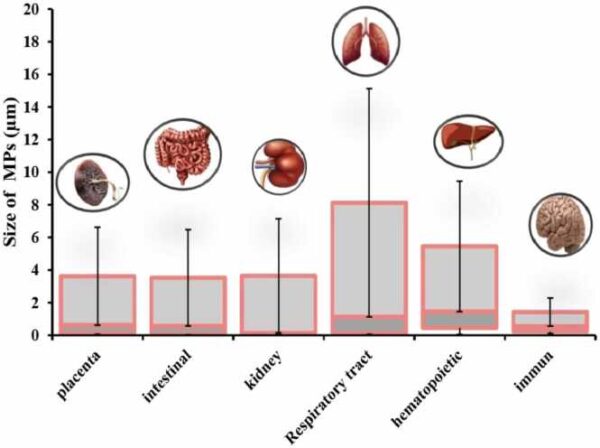Microplastics and Nanoplastics: What Science Tells Us About Their Effects

Microplastics and nanoplastics are widespread; current studies explore their sources, impacts, and engineering solutions for sustainability.
Found increasingly in both environmental and biological systems, microplastics (MPs, <5 mm) and nanoplastics (NPs, <1 μm) have become the subject of growing scientific attention. Research is expanding to characterize their properties, sources, transport mechanisms, and potential impacts. While their presence in natural systems is well-established, the health implications remain under active investigation. Evidence to date indicates that these particles may interact with biological systems through both physical and chemical pathways.
You can also read: Advancing Microplastics Characterization with FT-IR Microscopy.
Sources and Formation Pathways
Researchers generally categorize MPs and NPs into two groups. The first group, primary particles, includes those intentionally manufactured for specific applications, such as microbeads in cosmetics or abrasives in coatings.
Second, secondary particles result from the fragmentation of larger plastic items due to ultraviolet (UV) exposure, mechanical abrasion, or hydrolysis.
These particles originate from a range of sources, including synthetic textiles, road wear particles (particularly from tire abrasion), packaging degradation, and wastewater treatment effluent [1,2]. Once released into the environment, fragmentation continues, producing particles of varying sizes, shapes, and surface chemistries. This diversity influences their mobility and interactions with living organisms, linking manufacturing and product use directly to environmental presence.
Environmental Distribution
Research consistently confirms the widespread occurrence of MPs and NPs in marine, freshwater, soil, and atmospheric compartments. Detection methods—such as Fourier-transform infrared (FTIR) spectroscopy, Raman microscopy, pyrolysis-GC-MS, nanoparticle tracking analysis, and electron microscopy—enable identification across different size ranges [1].
Because of their low density and high chemical durability, MPs and NPs can persist for extended periods. Consequently, they have been documented to move across trophic levels in aquatic food webs and to deposit in remote terrestrial areas. Moreover, emerging studies suggest that atmospheric transport may represent an additional vector of exposure, especially for smaller particles that remain airborne [2].
Human Exposure and Toxicological Studies
Human exposure to MPs and NPs is thought to occur mainly through ingestion (via food and drinking water) and inhalation (from airborne dust and fibers), with dermal contact as a potential third route. Several recent studies have detected MPs in human blood plasma, stool, and placental tissue. However, reported concentrations and particle compositions vary significantly, in part because detection methods are not yet standardized [3,4].
Toxicological investigations—based largely on in vitro and animal models—indicate that particle size, surface area, and surface chemistry may affect biological responses. Documented potential effects include:
Induction of oxidative stress and inflammatory responses
Cellular uptake, particularly for particles smaller than 100 nm
Adsorption and transport of persistent organic pollutants (POPs) or heavy metals on particle surfaces [4,5]

Comparison of exposure size with human cell types. Courtesy of Micro- and nanoplastic toxicity in humans: Exposure pathways, cellular effects, and mitigation strategies.
It is important to highlight that there is currently insufficient evidence to draw firm conclusions about long-term human health risks from typical environmental exposure levels. This is because most laboratory studies use exposure concentrations far higher than those observed in the environment, and epidemiological data remain limited [3].
Recent Findings and Future Research Needs
Some recent studies have examined the capacity of NPs to cross biological membranes. Findings from animal models have demonstrated translocation across the intestinal barrier and, in certain cases, accumulation in the liver, kidneys, and brain [4,6]. While noteworthy, these results are preliminary and require further validation through human studies.
Ongoing research priorities include:
Standardizing detection and quantification techniques
Developing long-term chronic exposure models
Assessing particle-specific effects based on polymer type, morphology, and additive content
Implications for Industry and Engineering
For plastics engineering professionals, the emerging science around MPs and NPs presents a dual technical challenge.
First, materials innovation is needed to design polymers and additives that resist fragmentation and reduce micro- or nanoscale particle generation.
Second, process optimization can improve particle capture and recovery, especially in high-contribution sectors such as textiles, packaging, and automotive applications.
You can also read: Do Plastic Bottles Release Microplastics?
Advanced polymer design tools, coupled with life cycle assessment (LCA) methodologies, may play an increasingly important role in addressing these issues. As knowledge expands, sustained collaboration among material scientists, toxicologists, and environmental engineers will be essential for developing practical, evidence-based solutions.
Responsible Plastics 2025: Join the Conversation
As the understanding of MPs and NPs continues to develop, industry-wide collaboration and knowledge-sharing remain vital. One significant opportunity to engage with the latest research and cross-sector dialogue is Responsible Plastics 2025, taking place September 23–24 in Pittsburgh, PA. This event is designed for professionals committed to innovation, sustainability, and responsible practices, and it offers two focused tracks on pressing challenges: PFAS and Microplastics in the plastics industry.
We encourage readers to subscribe to this publication and consider attending the conference to contribute to solutions that balance performance, sustainability, and environmental responsibility. Learn more and register here.
References
Yee, M.S.L. et al. (2021). Impact of Microplastics and Nanoplastics on Human Health. Nanomaterials, 11(2), 496.
Kochanek, J. et al. (2025). Micro- and Nanoplastics in the Environment: Current State and Future Perspectives. Toxics, 13(7), 564.
Jahedi, M. et al. (2025). Micro‑ and nanoplastic toxicity in humans: Exposure, health risk, and mitigation strategies. PMC12142344.
Jayavel, R. et al. (2024). Impacts of micro and nanoplastics on human health. Bulletin of the National Research Centre, 48(1), 59.
Enyoh, C.E., et al. (2019). Environmental chemistry and toxicology of plastic pollution. Heliyon, 5(11), e02875.
Sharma, S., & Chatterjee, S. (2017). Microplastic pollution, a threat to marine ecosystem and human health: a short review. Environmental Science and Pollution Research, 24(27), 21530–21547.
